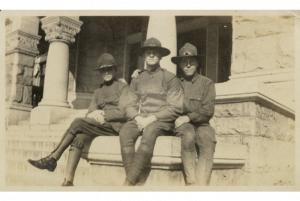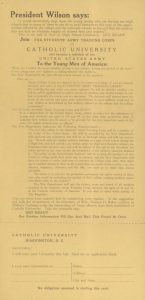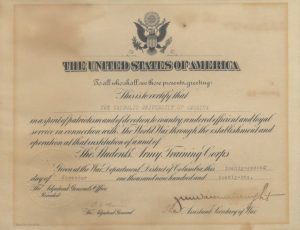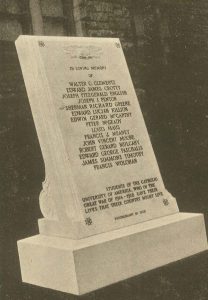
The decisive entry of the United States of America into the calamitous First World War on April 6, 1917 joining Britain and France against Imperial Germany was a momentous event in the history of the American Catholic Church. Making up about seventeen percent of the American population, Catholic support of the war effort was a watershed event to prove their patriotism. While many German and Irish Americans were not keen to assist the British, most Catholics believed it was a just war against an enemy whose submarines indiscriminately killed civilian passengers and oppressed the largely Catholic population of occupied Belgium. The fledgling Catholic University of America (CUA), established in 1887, was one of the first American Catholic institutions to declare itself when its rector, Bishop Thomas J. Shahan, wrote to President Woodrow Wilson on March 28, before the declaration of war, offering “such services as the Government of the United States may desire.” The President replied two days later expressing thanks “for your pledge of cooperation and support.”¹ Though partially addressed in a previous blog post, we now take a more in depth look at CUA’s wartime activities.

After the declaration of war, lay students military drilling on campus, forming three companies led by university instructors with prior military experience. A new gymnasium, ‘The Drill Hall,’ served both recreational and military needs. Many students also joined both reserve and active duty units. Soon, the U.S. War Department (a precursor to the Defense Department) inaugurated the Student Army Training Corps (SATC), an incarnation of today’s Reserve Officer Training Corps (ROTC). The SATC used over 100 college campuses as training facilities for new military personnel, including nearly 400 inducted from CUA, while the University’s Rev. Dr. Peter Guilday served as one of the SATC Regional Vice-Directors. CUA contributed to the state in other ways, such as vigorously promoting Liberty Loan subscriptions to help fund the war effort and permitting the United States Navy to use Albert and Gibbons Halls as a paymaster training school, graduating nearly 600. More ominously, the United States Army used the Maloney Hall laboratory for important chemical research, developing Lewisite Gas, which thankfully went into production too late for use in the war.

CUA also provided valuable service to the church as the venue for the founding of the National Catholic War Council, forerunner to today’s United States Conference of Catholic Bishops. Under the motto of ‘For God and Country’ and ably headed by CUA alumnus and Paulist priest, John Burke, a New York City native and Catholic newspaper editor, the NCWC represented Catholic interests ranging from charity to war before federal and state governments as well as secular and other religious organizations. By war’s end, some 800 CUA alumni and students had served in the military, with fifteen making the ultimate sacrifice, including Edward L. Killion, editor of the Cardinal Yearbook’s first issue in 1916. Additionally, more than 50 priest alumni had served as chaplains, probably the most famous being Francis P. Duffy of the famous ‘Fighting Sixty-ninth.’ The University’s postwar efforts included a rehabilitation school for wounded soldiers, administration of the Knights of Columbus Scholarships for ex-service men, and a 1922 campus memorial to honor CUA’s fallen.²

For more on CUA’s collections relating to the war please see the ‘Chronicling the U.S. Catholic Experience in the First World War’ web site.
¹Correspondence Files, CUA Rector-President Records, American Catholic History Research Center and University Archives.
²C. Joseph Nuesse. The Catholic University of America: A Centennial History. Washington, D.C.: CUA Press, 1990, pp. 176-177.
